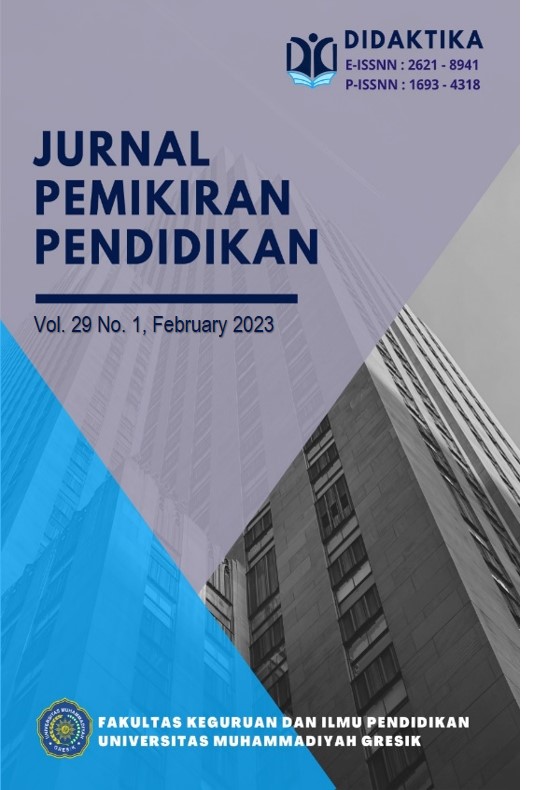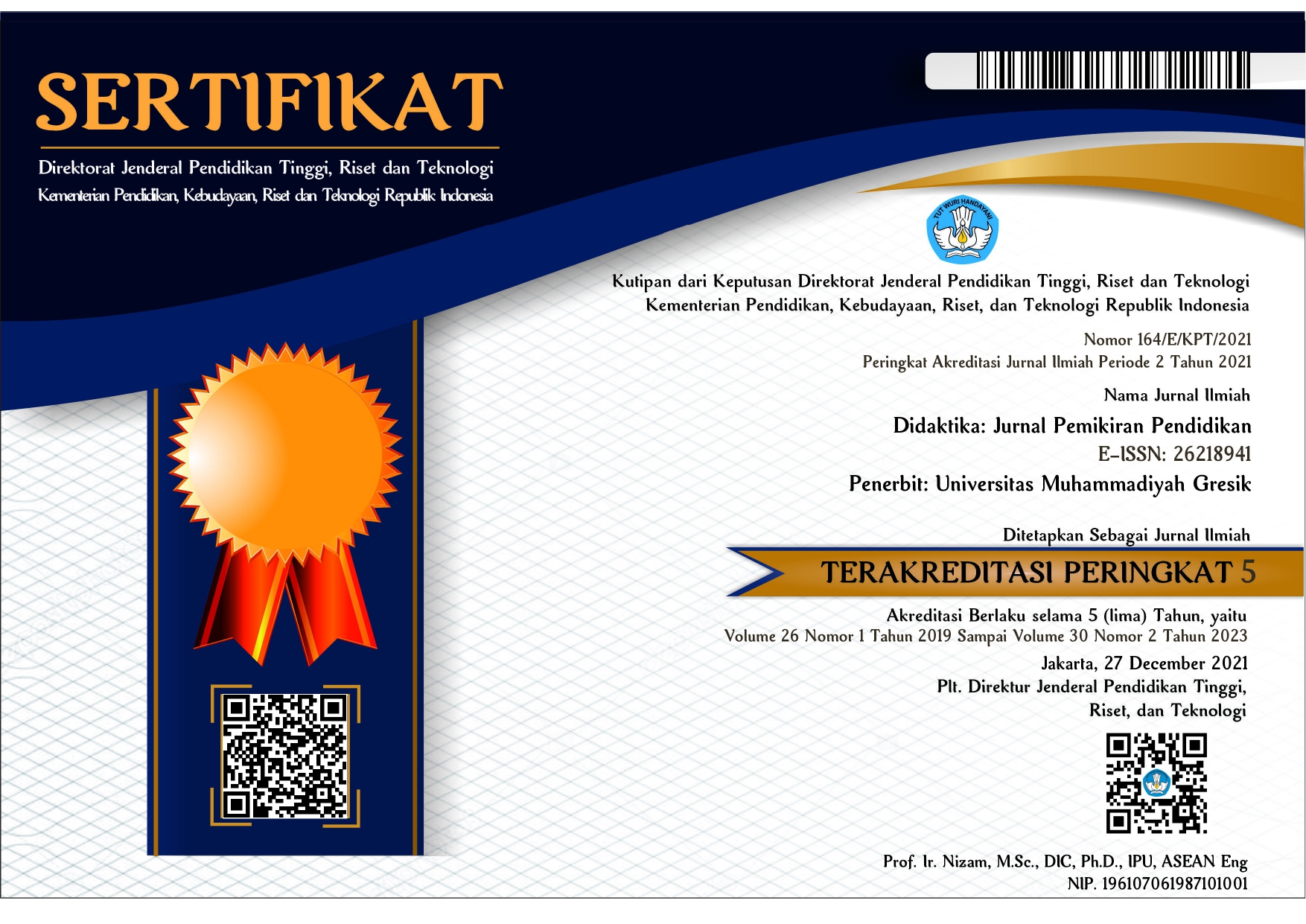The Effect Using Local Jokes Strategies To Improve Students’s Speaking Ability In Secondary Level
DOI:
https://doi.org/10.30587/didaktika.v29i1.5244Keywords:
Local joke; Pun; Speaking abilityAbstract
This paper aims to examine and compare the effects of word-play-based local humor strategies. In learning the speaking skills of EFL students at SMP Muhammadiyah 4 Gresik at the secondary level, in this study, 26 EFL students in classes VII A and VII B at an institution in the city of Gresik, East Java, were asked to become a research group, and they were divided randomly into two groups, namely the group experiments using pun-based local jokes and the control group using cooperative learning strategies based on TGT (Team Games Tournament). Each group contains 13 students. Prior to treatment, all participants took a pre-test, which aimed to ensure the homogeneity of these participants. The treatment for experimental participants, namely local jokes, was then started and continued with post-test speaking with material according to the syllabus. Data were then collected and analyzed through the paired samples T-test and independent samples T-test by comparing the results of the study groups before and after being given treatment and comparing the learning outcomes after being given treatment between groups, and the results then revealed that for students who were given more effective treatment, their scores were significantly higher than those of those who did not use conventional methods. The results of the control class students, who were not given any influence, were then lower than those of the experimental group. Thus, it can be concluded that there are significant differences between the experimental group and the control group in terms of how they are affected by the treatment.
References
Arian, T., & Mamaghani, H. J. (2019). Semi-online Planning: the Route to Fluency, Complexity, and Accuracy of EFL Learners’ Oral Production. The Asian EFL Journal Quarterly, 53.
Attardo, S. (2008). Semantics and pragmatics of humor. Language and Linguistics Compass, 2(6), 1203–1215. https://doi.org/10.1111/j.1749-818x.2008.00107.x
Bryant, J., Comisky, P., & Zillman, D. (1979). Teachers’ humor in the college classroom.
Communication Education, 28, 110-118.
Davies, C. E. (2015). Humor in intercultural interaction as both content and process in the classroom. HUMOR, 28(3). https://doi.org/10.1515/humor-2015-0065
Didiek Rahmanadjie, Sejarah, Teori, Jenis dan Fungsi Humor. Seni dan Desain Fakultas Sastra Universitas Negeri Malang. Dalam http://sastra.um.ac.id
Dynel, Marta. 2009. Humorous garden-paths: a pragmatic-cognitive study. Newcastle: Cambridge Scholars Publishing
Garner, R. (2005). Humor, analogy, and metaphor: H.A.M. it up in teaching.
Retrieved July 17, 2010, from http://radicalpedagogy.icaap.org/content/issue6_2/garner.html
Gönülal, T . (2018). Laughing Matters: ELLs’ Comprehension and Perceptions of Humor. Cumhuriyet International Journal of Education, 7 (4), 453-468. DOI: https://dx.doi.org/10.30703/cije.455199
Heidari-Shahreza, M. A. (2018). A cross-sectional analysis of teacher-initiated verbal humor and Ludic language play in an English as a foreign language (EFL) context. Cogent Education, 5(1), 1430474. https://doi.org/10.1080/2331186x.2018.1430474
Kruger, A. (1996). The nature of humor in human nature: Cross-cultural commonalities.
Counseling Psychology Quarterly, 9, 235-241
Larkin-Galiñanes, C. (2017). An overview of humor theory. The Routledge Handbook of Language and Humor, 4–16. https://doi.org/10.4324/9781315731162-2
Lefcourt, H. M. & Martin, R. A. (1986). Humor and Life Stress: Antidote to Adversity. New York: Springer-Verlag.
Matsumoto, Y. (2014). Collaborative co-construction of humorous interaction among ELF speakers. Journal of English as a Lingua Franca, 3(1), 81-107. DOI: https://doi.org/10.1515/jelf-2014-0004
Matsumoto, Y. (2014). Collaborative co-construction of humorous interaction among Elf speakers. Journal of English as a Lingua Franca, 3(1), 81–107. https://doi.org/10.1515/jelf-2014-0004
McGhee, P. E. (1983a). The role of arousal and hemispheric lateralization in humor. In P.E.
McGhee & J.H. Goldstein (Eds.), Handbook of humor research (Vol. I, pp. 109-134) New York: Springer-Verlag
Muñoz-Basols, J. (2005). Learning through Humor: Using humorous resources in the teaching of foreign Languages. The A.T.I.S. Bulletin, 42-46.
Najafi, M., Shahrokhi, M., Shojaee, M., & Atharizadeh, M. (2021). A comparative study of the effect of humor strategies on Iranian efl learners’ vocabulary learning. International Journal of Language Education, 5(4), 382. https://doi.org/10.26858/ijole.v5i4.15138
Paribakht, T.S., & Wesche, M. (1999). Reading and ‘Incidental’ L2 Vocabulary Acquisition.
Studies in Second Language Acquisition, 21, 195-229.
Petraki, E., & Pham Nguyen, H. H. (2016). Do Asian EFL teachers use humor in the classroom? A case study of Vietnamese EFL University Teachers. System, 61, 98–109. https://doi.org/10.1016/j.system.2016.08.002
POMERANTZ, A. N. N. E., & BELL, N. A. N. C. Y. D. (2011). Humor as safe house in the Foreign Language Classroom. The Modern Language Journal, 95, 148–161. https://doi.org/10.1111/j.1540-4781.2011.01274.x
Raskin V. (1985). Semantic Mechanisms of Humor. (pp. 113-114) Dordrecht-Boston-Lancaster: D. Reidel. In Wikipedia. Retrieved from https://en.m.wikipedia.org/wiki/Theories_of_humor#cite_ref-31
Raskin, V. (2017). Script-based semantic and ontological semantic theories of humor. The Routledge Handbook of Language and Humor, 109–125. https://doi.org/10.4324/9781315731162-9
Reddington, E., & Waring, H. Z. (2015). Understanding the sequential resources for doing humor in the language classroom. HUMOR, 28(1), 1–23. https://doi.org/10.1515/humor-2014-0144
Stuart, W. D., and Rosenfeld, L. B.1994. Student perceptions of teacher humor
and classroom climate. Communication Research Reports. 11. 87-97.
Syafiq, A. N., & Saleh, M. (2012). Humor English teaching material for improving students’
speaking skill with high and low learning motivation. Language Circle: Journal of Language and Literature, 7(1).
Wagner, M., & Urios-Aparisi, E. (2011). The use of humor in the Foreign Language Classroom: Funny and effective? Humor - International Journal of Humor Research, 24(4). https://doi.org/10.1515/humr.2011.024
Wanzer, M. B., Frymier, A. B., & Irwin, J. (2010). An explanation of the relationship between instructor humor and student learning: Instructional humor processing theory. Communication Education, 59(1), 1–18. https://doi.org/10.1080/03634520903367238
Wulf, D. (2010). A humor competence curriculum. TESOL Quarterly, 44(1), 155–169. https://doi.org/10.5054/tq.2010.215250
Wutun, A. A., Kesuma Wijaya, I., & Dahlan Bahang, M. (2021). The Power of Local Language Terms in Creating Humor in English Language Teaching. Eralingua: Jurnal Pendidikan Bahasa Asing Dan Sastra, 5(2), 483–491. https://ojs.unm.ac.id/eralingua
Zillman, D., & Bryant, J. (1983). Uses and effects of humor in educational ventures. In P. E.
McGhee & J. H. Goldstein (Eds.), Handbook of Humor Research, Volume 2: Applied
Studies, 173-194. New York: Springer-Verlag.
Ziv, A. (1988). Teaching and learning with humor: Experiment and replication. Journal of
Experimental Education, 57 (1), 5-15.
Downloads
Published
How to Cite
Issue
Section
License
License and Copyright Agreement
In submitting the manuscript to the journal, the authors certify that:
- They are authorized by their co-authors to enter into these arrangements.
- The work described has not been formally published before, except in the form of an abstract or as part of a published lecture, review, thesis, or overlay journal.
- That it is not under consideration for publication elsewhere,
- That its publication has been approved by all the author(s) and by the responsible authorities – tacitly or explicitly – of the institutes where the work has been carried out.
- They secure the right to reproduce any material that has already been published or copyrighted elsewhere.
- They agree to the following license and copyright agreement.
Copyright
Authors who publish with DIDAKTIKA: Jurnal Pemikiran Pendidikan agree to the following terms:
- Authors retain copyright and grant the journal right of first publication with the work simultaneously licensed under a Creative Commons Attribution License (CC BY-SA 4.0) that allows others to share the work with an acknowledgment of the work's authorship and initial publication in this journal.
- Authors are able to enter into separate, additional contractual arrangements for the non-exclusive distribution of the journal's published version of the work (e.g., post it to an institutional repository or publish it in a book), with an acknowledgment of its initial publication in this journal.
- Authors are permitted and encouraged to post their work online (e.g., in institutional repositories or on their website) prior to and during the submission process, as it can lead to productive exchanges, as well as earlier and greater citation of published work.
Licensing for Data Publication
Open Data and Software Publishing and Sharing
The journal strives to maximize the replicability of the research published in it. Authors are thus required to share all data, code or protocols underlying the research reported in their articles. Exceptions are permitted but have to be justified in a written public statement accompanying the article.
Datasets and software should be deposited and permanently archived inappropriate, trusted, general, or domain-specific repositories (please consult http://service.re3data.org and/or software repositories such as GitHub, GitLab, Bioinformatics.org, or equivalent). The associated persistent identifiers (e.g. DOI, or others) of the dataset(s) must be included in the data or software resources section of the article. Reference(s) to datasets and software should also be included in the reference list of the article with DOIs (where available). Where no domain-specific data repository exists, authors should deposit their datasets in a general repository such as ZENODO, Dryad, Dataverse, or others.
Small data may also be published as data files or packages supplementary to a research article, however, the authors should prefer in all cases a deposition in data repositories.











